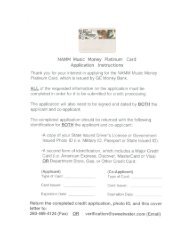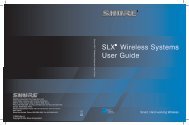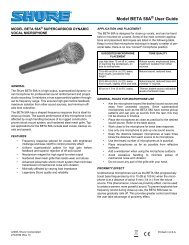Create successful ePaper yourself
Turn your PDF publications into a flip-book with our unique Google optimized e-Paper software.
Performance Functions and Effects<br />
Parameter Value Explanation<br />
Osc2 & Sync<br />
Osc 2<br />
Waveform<br />
Osc 2 Pulse<br />
Width<br />
Osc 2<br />
Coarse<br />
Tune<br />
Osc 2 Fine<br />
Tune<br />
(same as Osc 1)<br />
Osc 2 Level 0–127 Adjust the level.<br />
Osc Sync<br />
Switch<br />
OFF, ON<br />
Turning this switch on<br />
produces a complex sound<br />
with many harmonics.<br />
This is effective when the<br />
OSC1 pitch is higher than the<br />
OSC2 pitch.<br />
Parameter Value Explanation<br />
LFO<br />
LFO Rate 0–127 Modulation speed of the LFO<br />
LFO Osc 1<br />
Pitch Depth<br />
LFO Osc 2<br />
Pitch Depth<br />
LFO Osc 1<br />
Pulse<br />
Width<br />
Depth<br />
LFO Osc 2<br />
Pulse<br />
Width<br />
Depth<br />
-63– +63<br />
-63– +63<br />
Depth to which the LFO will<br />
modulate the Osc 1/2 pitch<br />
Depth to which the LFO will<br />
modulate the pulse width of the<br />
Osc 1/2 waveform<br />
* The Pulse Width is<br />
activated when “SQR” is<br />
selected with Osc 1/2<br />
waveform.<br />
Assigning a function to the D Beam<br />
controller<br />
Filter<br />
Filter Type<br />
OFF, LPF,<br />
BPF, HPF,<br />
PKG<br />
Cutoff 0–127<br />
Resonance 0–127<br />
Type of filter<br />
OFF: No filter is used.<br />
LPF: Low Pass Filter. This<br />
reduces the volume of all<br />
frequencies above the cutoff<br />
frequency (Cutoff) in order to<br />
round off, or un-brighten the<br />
sound.<br />
BPF: Band Pass Filter. This<br />
leaves only the frequencies in<br />
the region of the cutoff<br />
frequency, and cuts the rest.<br />
HPF: High Pass Filter. This cuts<br />
the frequencies in the region<br />
below the cutoff frequency.<br />
PKG: Peaking Filter. This<br />
emphasizes the frequencies in<br />
the region of the cutoff<br />
frequency.<br />
Frequency at which the filter<br />
begins to have an effect on the<br />
waveform’s frequency<br />
components<br />
Emphasizes the portion of the<br />
sound in the region of the<br />
cutoff frequency, adding<br />
character to the sound.<br />
* Excessively high settings can<br />
produce oscillation, causing<br />
the sound to distort.<br />
1. Press and hold [ASSIGNABLE 1] or [ASSIGNABLE 2].<br />
The D BEAM screen will appear.<br />
2. Use [ ] [ ] to select a parameter.<br />
3. Turn the VALUE dial to select the desired D Beam function.<br />
4. When you’ve finished making settings, press [EXIT].<br />
The Main screen will appear.<br />
These settings are system parameters (p. 46).<br />
Functions that can be assigned<br />
D Beam<br />
function<br />
DRUM<br />
ROLL<br />
CHIMES<br />
BUBBLE<br />
Explanation<br />
A snare drum roll will continue as long as your<br />
hand is positioned over the D Beam. Move<br />
your hand closer to increase the volume, and<br />
move your hand rapidly away to play a<br />
cymbal.<br />
Chimes will sound when you position your<br />
hand above the D Beam. The volume is greater<br />
when you move your hand more rapidly.<br />
The sound of bubbles will continue as long as<br />
your hand is positioned above the D Beam. The<br />
volume will increase as you move your hand<br />
closer.<br />
35
















